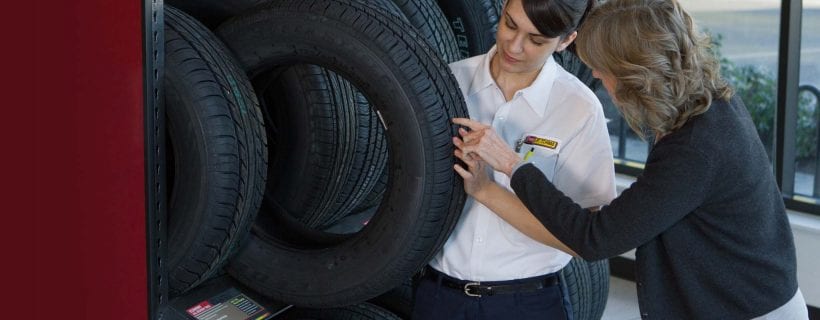Your tires are literally where the rubber meets the road. You rely on them to keep you and all of your passengers safe. Your set probably looks fine from a distance. But if they have been on your car for a long time, you are likely to face changing them soon. How do you know when it is time to make this switch?
How do I know when I need to replace a tire?
A blowout is the worst-case scenario for this part change. Driving when it loses pressure is frustrating, dangerous and a serious hassle for people in a time crunch. Otherwise, you need to consider tread depth and manufacture date, which are your most important indicators for a replacement.
When the tread becomes worn, your tire does not hold the road as it should. It loses traction, particularly during braking and when driving in inclement weather. Even if you have plenty of tread left, it is time for a change-out if the manufacturing date is six years ago or longer. Rubber dries and cracks over time, raising your risk for a flat or a blowout.
Check Tread Depth
To check your tread depth, park your vehicle in a safe space with good lighting. Also, put on a pair of gloves. Otherwise, you will get black debris all over your hands. This material easily transfers to just about any surface and can stain.
You need a penny and a quarter for the easiest measuring of the tread. First, insert the quarter into the tread along the middle of the tire. Point George Washington’s head downward, toward the center of the tire. If George’s head top is even with your tire tread, it is almost time for a change. You can safely drive for long enough to find the best options for your vehicle.
Insert a penny the same way you did with the quarter. If the tread is even with the top of Abe Lincoln’s head, you have a safety concern with your tire. You need immediate replacement.
Check the Manufacture Date
As said before, you should never keep a wheel on your vehicle beyond its sixth year after manufacturing. Otherwise if its not beyond its sixth year, wheel replacements are mainly for driving your vehicle better, weather conditions, road conditions and other factors. But no matter how much tread remains on your wheels, when its over six years-old it must be replaced.
To know when your it rolled off the assembly line, check for the Department of Transportation’s code on the tire wall. This four-digit code is simple to decipher. The first two numbers are the week number. The last two numbers are the year. With the number 1019 on your tire wall, for example, it was made in the 10th week of 2019.
Although decoding is easy, finding the code can take a moment. There are possibly other numbers and letters also printed on the sidewall. Your best bet is to look for a four-digit number with the last two being a recent year. Of course, if you need help with this, any mechanic or vehicle shop can help you out.
Finding the Right Tire for Your Ride

Now that you have a basic idea of what to look for toward tire safety, you also need to know which replacements to choose. There is no single “best answer” for everyone when it comes to tire shopping. Below is a simple guide to help you find your ideal options.
What size do you need?
Look in your owner’s manual or on the driver’s side doorjamb placard to find the tire specs for your vehicle. The label typically reads like “P215/60R16 94T.” Your tire size will likely be different, but very similar in these digits and letters.
The first part of this number series, the P215/60R16 provides width and diameter. While the 94 at the end is the load index, indicating how much weight it can carry. The last letter “T” is the speed rating. Simply take a smartphone photo of this number or write it down for your tire shop salesperson. You need to match these measurements but can choose a higher load index or speed rating if desired.
What type do you need?
The next step after size is to find your ideal type of tire. You still need to match that important speed rating. Options for your selection include:
- All-season with S- and T-speed ratings for good grip year-round and long mileage
- Performance all-season with H- and V-speed rating for cars with upgraded wheels and drivers who seek performance over long term wear
- Ultra-high performance all-season and summer with ZR-, W- and Y-ratings for performance vehicles and sports cars
- All-season and all-terrain truck tires for light-duty trucks and SUVs with off-road grip and “A/T” or “All Terrain” in the model name
- Winter/snow tires with “busy” tread with many sipes, showing a snowflake or mountain symbol on the sidewall
What are your tire priorities?
As your vehicle ages, you possibly want to switch to a different type of tire than you had on your newly purchased ride. You need to decide your priorities for your purchase, such as performance or lower price. Consider things like tread life and performance ratings from leading review organizations. You can also find helpful selection information on manufacturer websites. Ultimately the decision is yours, depending on what you want from your tire performance.
Never Put Off Replacement When Needed

If you notice tread wear, know your manufacture date is long gone or have other signs of tire problems, you should never put off making the switch. Although this is a big investment for your vehicle maintenance, it is a lifesaving one. In fact, your wheels are your car, truck or SUV’s most important safety feature. They also help you enjoy a more comfortable ride and can improve fuel economy. Take a moment out of your busy schedule to check your tread depth and manufacture date. You may be surprised by what you find, and you could even save a life. Visit: https://goodtirecalgary.ca/ to receive more information or your new wheels today.


